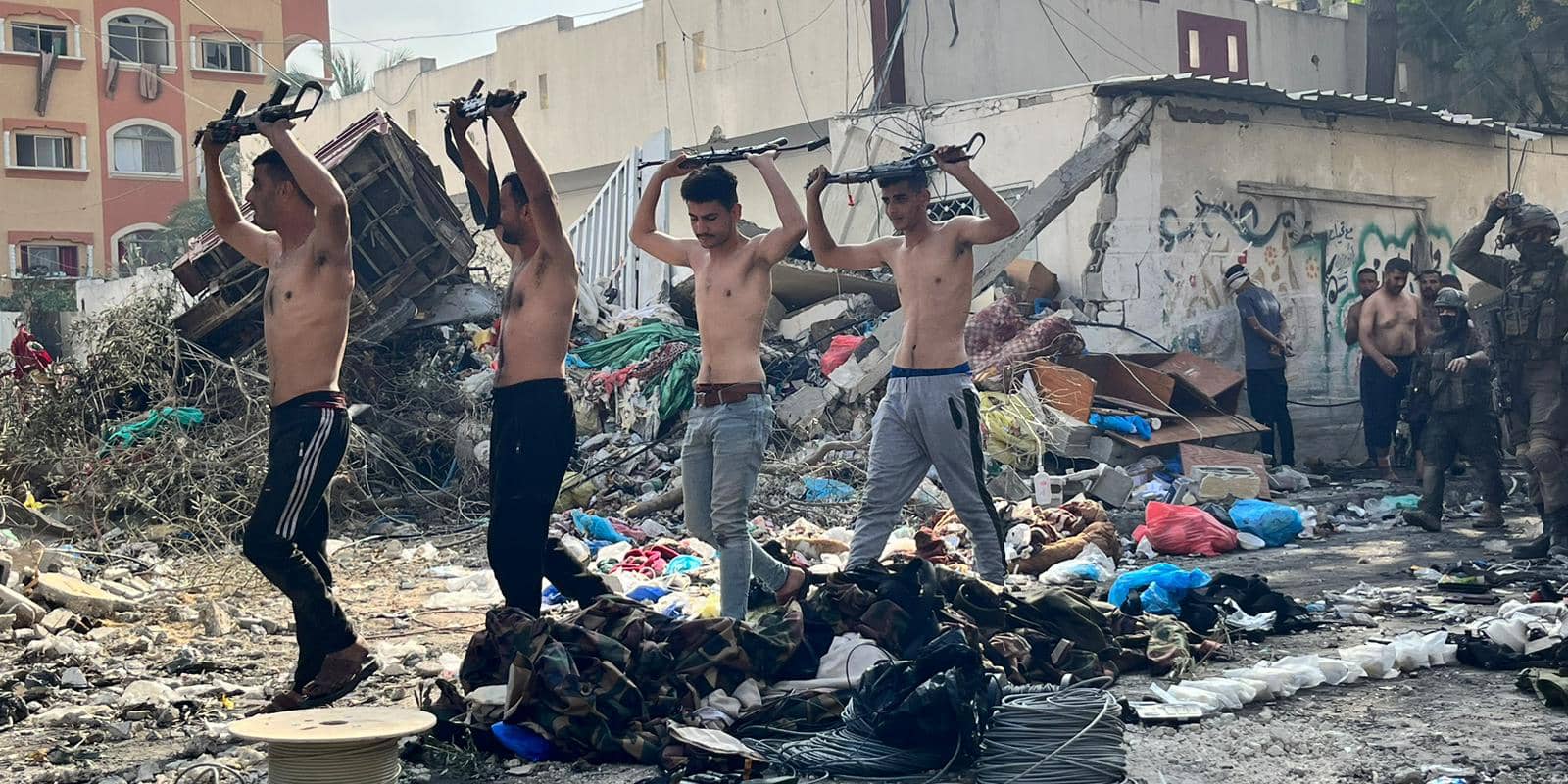Beyond the intelligence value obtained and the possible leverage for the release of Israeli hostages, the symbolic signal sent by images of Hamas terrorists giving themselves up is strategically significant. Debunking the myth that Islamist “heroes” are willing to fight to the death, unlike their secular nationalist predecessors in past wars against Israel, should be among the long-term goals of the present conflict.
Debunking the myth that Islamist “heroes” are willing to fight to the death, unlike their secular nationalist predecessors in past wars against Israel, should be among the long-term goals of the present conflict. The evidence is increasingly available. Despite the deliberate lack of full disclosure and official data, it is safe to assert that the number of Hamas armed men (and others belonging to smaller terror groups) who have given themselves up in battle in Gaza has been rising since the beginning of 2024, specifically during the fighting in Khan Younis and Shifa Hospital. Beyond the intelligence value obtained and the possible leverage for the release of Israeli hostages, the symbolic signal that these images send is strategically significant.
Given the lack of information on the hostages held in Gaza, Israel avoids, as a policy, the disclosure of full and official data as to the numbers of combatants belonging to Hamas, and other terror groups, who surrendered and were taken prisoner by the IDF during the fighting. Still, it is safe to say that their number has risen significantly, particularly during the operations in Khan Younis (and in the battle to re-take the al-Shifa Hospital), indicating growing disorder and demoralization.
Achieving the surrender of large numbers of enemy fighters is advantageous, first of all, in terms of incurring fewer casualties and requiring less military effort than a “fight to the finish.” It has also been proven to be of immense value in obtaining vital intelligence, such as the location of tunnels and their entrances. Another operational consideration has to do with improving Israel’s leverage in the negotiations for the hostages’ release.
Yet in addition, the surrender of Hamas armed men is also of long-term value at the level of grand strategy. For decades, the Islamist totalitarian terrorist groups, from Hizbullah and Hamas to al-Qaeda and the Islamic State Iraq and the Levant (ISIL, Da’esh), have cultivated the legend that the Muqawwamah (“resistance”), rooted in (a version of) religious faith, will stand and fight to the last – unlike the symbols of flight and surrender which marked the defeat of secular Arab nationalism, above all in the war of 1967.
As against “the shoes in the sand”, still etched in the Arab collective memory, they posit the willingness, even eagerness, for Shahada (a martyr’s death) – whether that of the suicide bombers or of fighters in the field. Indeed, in the Second Lebanon War in 2006 and the limited ground incursions into Gaza in 2008 and 2014 (there was no ground maneuver in 2012 or 2021) very few prisoners were taken, enhancing the myth, and adding to the appeal of Islamist ideas around the region.
Thus, the change now taking place in Gaza is of great symbolic significance, which Israel should work to enhance. This does not require the publication of humiliating images, which in the West invoke unpleasant associations with the Abu-Ghraib jail scenes during the American occupation of Iraq. However, documenting the actual acts of surrender and spreading images that reverse and debunk the myth – raising questions as to the Islamists’ willingness to sacrifice, while they bring about a disaster for their people – is a strategic asset in the overall war of ideas against totalitarian Islamism across the region.
What Gave the Myth of the Muqawwamah (“Resistance”) its Resonance?
During the heady first decades after the collapse of colonialism and the rise of independent Arab states, they were usually dominated by a secular, nationalist and modernist ideology – such as Nasserism in Egypt: But all this was shattered in 1967. The images of defeat, flight and the surrender of thousands on the battlefields of the Six-Day War are still bitterly remembered, and occasionally surface in political caricatures – symbolized by the shoes left behind in the sand.
Islamists latched on to these images and their implications to suggest that the secular, national and socialist regimes, such as Nasser’s or the Ba’ath (“renaissance”) party, failed to fire up the ranks of their soldiers with the necessary spirit of resilience and willingness to sacrifice “fi sabil Allah” – in G-d’s cause, in pursuit of the duty of Jihad and in obedience to religious injunctions. As an alternative, they depict the various Islamist movements and combatants, whether in Lebanon, Gaza, or across the region, whose men “love death” and are therefore indomitable.
This message, repeated in the formative texts of these movements – such as the speeches of Hizbullah leader Hassan Nasrallah – also seeks to bring about the demoralization of the Israeli public: “You,” Zionists love the good life and cling to it, while “we” eagerly await the realization of our wish for the shahada, literally a “testimonial” death (that of those who fell in battle or sacrificed their lives in a religiously significant conflict, i.e. with presumed enemies of Islam). Therefore, down the road Israel is bound to be defeated. The sacrificial myth of the “resistance” is therefore meaningful in terms of constructing concepts and expectations about the future of the conflict, as well as in mobilizing fighters and building up their self-image as those who save the honor of people who were humiliated by surrender (and at the level of policy, by the acceptance of Israel’s right to exist).
These images of steadfastness (Sumud) and willingness to sacrifice have their bearing also on the regional balance of power. At least in theory, they weaken and undermine the “camp of stability” – which Israel is part of, in practice – and play into the hands of the various Islamist camps: Iran, its proxies (especially Hizbullah) and allies; the Muslim Brotherhood and its offshoots, including Hamas; and the Jihadist terror groups such as al-Qaeda and ISIL. Today’s reality is that these images are spread not only by the traditional media channels which support the Islamists – such as Al Jazeera in Qatar and the Beirut-based Al-Mayadeen channel, associated with Hizbullah – but also by the posting of “heroic” stances and actions on social networks.
The Implications of Extensive Surrenders
It is this intensely nurtured image of heroism and an indomitable spirit, and the specific historical context, which lends deep meaning to the growing numbers of Hamas men who choose surrender over death. Aspects of the IDF operations in both Khan Younis and the major repeat raid on Shifa Hospital (where hundreds were reportedly detained) contributed to the achievement of this result. In some of the cases, the surrender was also documented by media elements.
All this has immediate tactical benefits:
- The signs of demoralization and loss of fighting spirit in the enemy ranks in key places can lead to a similar effect in other sectors.
- The surrender of armed men clearly reduces the extent of the actual fighting while expanding the scope of operations – albeit at the cost of having to assign troops and resources for the transportation and detention of those detained.
- Above all, the interrogation of the terrorists detained can produce qualitative intelligence on their strengths and deployment, particularly on the system of tunnels. The latter has turned out to be far more extensive and ambitious than the picture obtained before the war through other collection channels.
At the operational level – aimed at achieving the war’s overall goals – Israel is holding a steadily growing number of Hamas operatives also as a lever to negotiate the release of all remaining hostages and hasten the organizational collapse of the organization’s command structure.
Still, the most far-reaching implication is at the symbolic level: effectively debunking the myth of sacrifice, nurtured by the “Axis of Resistance” in recent decades, by putting a spotlight on the patterns of surrender. This can serve as a message both to the Gazans themselves, whose life Hamas was willing to sacrifice unhesitatingly and in great numbers, and to much wider circles in the Arab and Muslim world where this myth has taken hold.
What needs to be done?
As already applied in both Khan Younis and the Shifa raid (in the latter, according to IDF sources, a “bonanza” of information became available, when hundreds of Hamas operatives surrendered), military operations at this stage should be geared towards creating the conditions and situations that will lead Hamas armed men to lay down their weapons and give themselves up. This should obviously be done with all the due caution made necessary by the danger of fighters pretending to surrender. To the extent that this can achieved without risking soldiers’ lives, they should be arrested (the term “taken as a POW” does not apply to terrorists) and their capture used both for intelligence production and for symbolic effect.
For reasons having to do with the ongoing dialog with the Americans and other friends in the West, the images disseminated should be carefully monitored: if they are too humiliating, they tend to conjure up the documented abuse of prisoners at the Abu-Ghraib Jail, which seriously damaged the legitimacy of the American campaign in Iraq. Clips of nearly-naked detainees – even if they do reflect the operational need to ensure there are no hidden arms or explosives on them – have had a harmful effect on the IDF’s reputation.
On the other hand, the actual documentation of the acts of surrender to the IDF – accompanied, if possible, by broad statistical data, and as has already been done occasionally, clips from the questioning of Hamas prisoners – is of profound strategic significance. Indeed, it can be said to pertain to the realm of grand strategy in the message it would convey, insofar as it colors the prospects in the long-term and existential struggle against Islamist totalitarianism and its moral and ideological pretenses. The effective steps Israel can take in this respect are also of importance to its regional standing, insofar as it remains an important part of the “Camp of Stability” which confronts the ideological, political and military challenges posed by movements such as Hamas (and Hizbullah) to the existing pro-western regimes.
JISS Policy Papers are published through the generosity of the Greg Rosshandler Family.
Photo: IDF Spokesperson’s Unit









 - בניית אתרים
- בניית אתרים